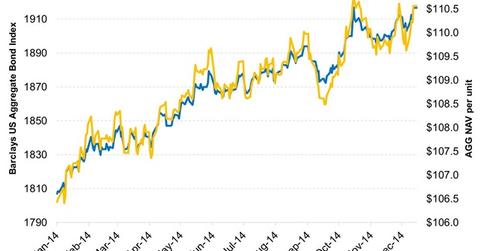Calculating A Bond ETF’s Underlying Value
The calculation of a bond ETF’s underlying value is going to be less precise than a stock ETF’s underlying value.
Dec. 22 2014, Updated 2:14 p.m. ET

How they calculate underlying value
Bonds trade OTC, and there’s typically no central market where investors can see where bonds were bought and sold. At the same time the majority of bonds do not trade every day and so their value must be estimated based upon available market information. This means that the calculation of a bond ETF’s underlying value is going to be less precise than a stock ETF’s underlying value. As a result, bond ETFs tend to experience more premiums and discounts, or deviation between the closing ETF price and the closing NAV.
Market Realist –  Calculating the underlying value of bond ETFs
The above chart shows the iShares Core U.S. Aggregate Bond ETF (AGG) and its underlying index, the Barclays U.S. Aggregate Bond Index. The AGG is one of the most active fixed-income ETFs, with net assets exceeding $20 billion and average trading volumes, more than 500,000 units.
The Barclays U.S. Aggregate Index is considered one of the most favored total bond market indices representing all investment grade US bonds. Another example of a total bond market fund is the Vanguard Total Bond Market ETF (BND) that seeks to track the performance of the Barclays U.S. Aggregate Float Adjusted Index.
It can be observed clearly that the NAV (net asset value) and the value of the underlying index do not always converge. That’s different from equity ETFs (SPY)(IVV) and their underlying indices, as we saw in the previous part of this series.
ETFs are traded like shares and the bid-ask spread here is determined by factors such as liquidity in the underlying securities, market volatility (VXX), etcetera. ETFs are also governed by market supply and demand fluctuations.
The last part in this series explains why the net asset value of an ETF is the best estimate of bond prices.
